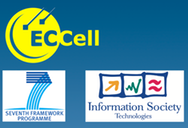The core functions for ECCells harbour themselves powerful opportunities for information processing. The basic copy process of molecular replication is realized in such a way that a multitude of related processes involving the selective amplification and recombination of information can also be programmed: for example from the production of specific subsequences to the linkage of sequences containing specific subsequences. Likewise, the process of programmable containment is actually a member of a family of powerful molecular information processing primitives allowing selective retention, concentration, isolation and release of specific molecules. Similarly, the electronic activation chemistry allows specific gating of the other processing steps.
In ECCell, instead of implementing these processing steps as predefined entities, they are embedded in a feedback control architecture via the optical imaging system that allows processing steps to be modulated for completion.
The functionalization of the reversible cross-linked polymer matrices with specific subsequences for DNA binding will be pursued jointly as a continuation of the work on the ECCell cycle. The programmabilty of this functionalization will be tested by partner 1a in the microfluidic processing modules developed in WP4. The electronic reversibility of the gelation process will be developed in a collaboration.
